-
 Bitcoin
Bitcoin $107,467.9126
1.26% -
 Ethereum
Ethereum $2,447.5288
-0.12% -
 Tether USDt
Tether USDt $1.0005
0.00% -
 XRP
XRP $2.1921
0.13% -
 BNB
BNB $647.2897
0.50% -
 Solana
Solana $144.8627
-0.37% -
 USDC
USDC $0.9996
-0.03% -
 TRON
TRON $0.2732
0.10% -
 Dogecoin
Dogecoin $0.1652
-0.18% -
 Cardano
Cardano $0.5700
-2.87% -
 Hyperliquid
Hyperliquid $37.0274
-1.81% -
 Bitcoin Cash
Bitcoin Cash $484.6957
0.19% -
 Sui
Sui $2.7354
-2.19% -
 Chainlink
Chainlink $13.1727
-1.49% -
 UNUS SED LEO
UNUS SED LEO $8.9978
-0.04% -
 Stellar
Stellar $0.2421
-2.33% -
 Avalanche
Avalanche $17.5633
-3.51% -
 Toncoin
Toncoin $2.8476
-1.94% -
 Shiba Inu
Shiba Inu $0.0...01166
-0.56% -
 Litecoin
Litecoin $85.1071
0.09% -
 Hedera
Hedera $0.1502
-2.96% -
 Monero
Monero $310.2774
-1.64% -
 Dai
Dai $0.9999
-0.01% -
 Polkadot
Polkadot $3.3584
-1.88% -
 Ethena USDe
Ethena USDe $1.0003
-0.04% -
 Bitget Token
Bitget Token $4.4443
2.90% -
 Pi
Pi $0.6242
14.04% -
 Uniswap
Uniswap $6.9774
-2.86% -
 Pepe
Pepe $0.0...09535
-5.05% -
 Aave
Aave $256.7574
-3.35%
Can I chase it if the continuous small positive lines push it up but the increase is limited?
Continuous small positive lines in crypto charts suggest gradual accumulation, but traders should confirm with volume and indicators before chasing gains.
Jun 26, 2025 at 03:42 pm
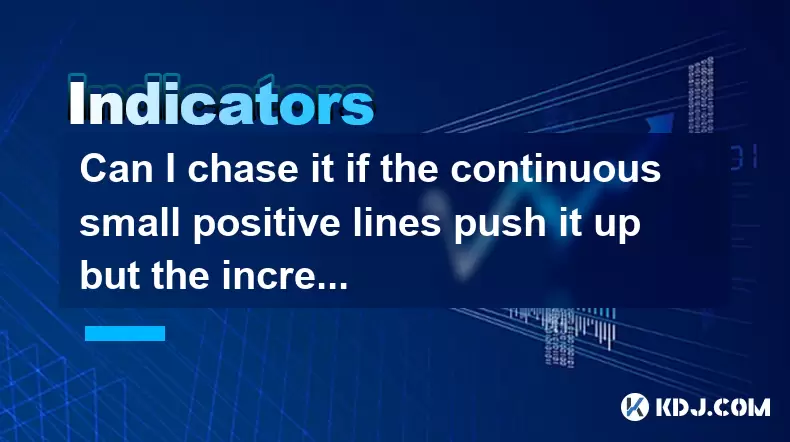
Understanding the Concept of Continuous Small Positive Lines
In the realm of cryptocurrency trading, continuous small positive lines refer to a pattern where an asset's price consistently rises in small increments over a period. These movements are typically observed on candlestick charts and can indicate underlying strength or accumulation by larger players in the market.
When traders encounter this pattern, they often wonder whether it’s wise to chase the price higher, especially when the overall increase remains limited despite the persistent upward pressure. This scenario raises several important questions about market psychology, technical analysis, and risk management.
Continuous small positive lines may suggest that demand is gradually increasing without triggering large sell-offs.
What Drives the Pattern of Small Positive Candles?
This particular chart formation usually occurs when buyers are stepping in at regular intervals, absorbing available supply without causing a sharp spike in price. The absence of large bullish candles indicates that the uptrend is not being driven by panic buying or hype, which can be both a sign of healthy accumulation and a warning of stalled momentum.
- Gradual buying pressure: Institutional investors or whales may be slowly accumulating without moving the price too aggressively.
- Limited volatility: Markets with low volatility tend to produce these patterns more frequently.
- Market indecision: Retail traders might be hesitant to commit capital due to unclear fundamental catalysts.
Identifying the driving force behind small positive lines helps determine whether chasing the move is justified.
Technical Indicators That Can Help Confirm Strength
Relying solely on candlestick formations can lead to false signals. It's crucial to incorporate additional tools for confirmation:
- Volume Profile: Increasing volume on up days suggests stronger conviction among buyers.
- Moving Averages: If the price remains above key moving averages like the 20-day or 50-day EMA, it could signal ongoing support.
- RSI and MACD: These momentum indicators help assess whether the asset is overbought or if momentum is still building.
A rising RSI alongside consistent volume supports the validity of small positive line formations.
Risk Considerations When Chasing Small Gains
Chasing price action based on small positive lines carries inherent risks. Since the increases are limited, entering late in the pattern could result in minimal reward relative to potential downside risk. Traders must evaluate:
- Entry points: Buying near the close of the latest positive candle may offer less favorable risk-reward ratios.
- Stop-loss placement: Tight stops may get triggered prematurely during consolidation phases.
- Position sizing: Reducing position size can mitigate losses if the pattern fails.
Risk management becomes even more critical when chasing subtle price movements in crypto markets.
Historical Examples in Cryptocurrency Markets
Looking at past behavior of major cryptocurrencies like Bitcoin and Ethereum reveals numerous instances where small positive lines preceded either breakouts or reversals:
- In early 2021, ETH displayed multiple small green candles before breaking out above $2,000.
- Conversely, during the 2022 bear market, similar patterns often led to failed rallies followed by renewed selling pressure.
Analyzing such historical data provides context on how to interpret current patterns in altcoins or even broader market indices.
Past performance of small positive line patterns offers insight into possible future outcomes but should not be used in isolation.
How to Approach Trading Based on This Pattern
If you're considering chasing small positive moves, here’s a structured approach to follow:
- Wait for confirmation: Look for a breakout above resistance or a surge in volume before committing capital.
- Use limit orders: Avoid chasing market orders that may execute at unfavorable prices.
- Monitor order books: Depth analysis can reveal hidden buying or selling pressure.
- Combine with news flow: Fundamental developments can validate or invalidate technical setups.
- Set realistic targets: Don’t expect explosive moves from small positive line patterns unless momentum builds.
Patience and precision are essential when deciding to trade based on small positive line formations.
Frequently Asked Questions (FAQ)
Q: What timeframes are most reliable for identifying small positive line patterns?
A: These patterns are most effective on daily and 4-hour charts, where short-term noise is reduced and institutional activity is more visible.
Q: Should I ignore small positive lines if they occur during a downtrend?
A: Yes, especially if they fail to show increasing volume or coincide with bearish indicators like lower highs and lower lows.
Q: Can small positive lines appear in sideways markets?
A: Absolutely. In ranging conditions, they may reflect accumulation rather than trend continuation and require additional confirmation.
Q: How does volatility affect the reliability of small positive line patterns?
A: High volatility can distort the pattern, making it less reliable. Low to moderate volatility environments tend to produce clearer signals.
Disclaimer:info@kdj.com
The information provided is not trading advice. kdj.com does not assume any responsibility for any investments made based on the information provided in this article. Cryptocurrencies are highly volatile and it is highly recommended that you invest with caution after thorough research!
If you believe that the content used on this website infringes your copyright, please contact us immediately (info@kdj.com) and we will delete it promptly.
- BNB Price Check: Can Binance Coin Reserves Fuel a Rally to $800?
- 2025-06-26 20:25:12
- PEPD, Memes, and Ethereum: A New Era of Meme Utility?
- 2025-06-26 20:25:12
- DOGE, BlockDAG, and Coin Airdrops: The New Wave of Crypto Opportunities
- 2025-06-26 18:45:12
- Neo Pepe and the Crypto Presales Popping in June 2025
- 2025-06-26 18:45:12
- Bitcoin, DeFi Tokens, and Relist Moves: What's Hot in Crypto Right Now
- 2025-06-26 18:30:11
- Binance, Bitcoin, and Altcoins: Navigating the Crypto Landscape
- 2025-06-26 19:05:12
Related knowledge
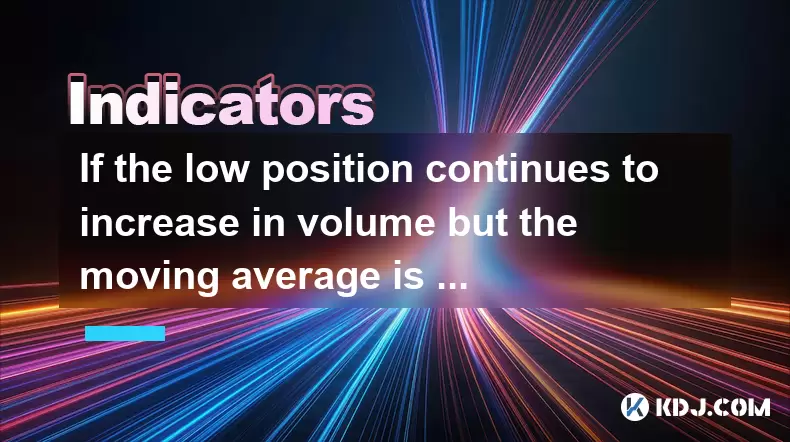
If the low position continues to increase in volume but the moving average is still short, should we wait and see?
Jun 26,2025 at 08:07pm
Understanding the Scenario: Low Position with Increasing VolumeIn the cryptocurrency market, traders often encounter situations where a particular asset is trading at a relatively low price level (referred to as a 'low position'), yet there is a noticeable increase in trading volume. This phenomenon can be confusing because it suggests that more market ...
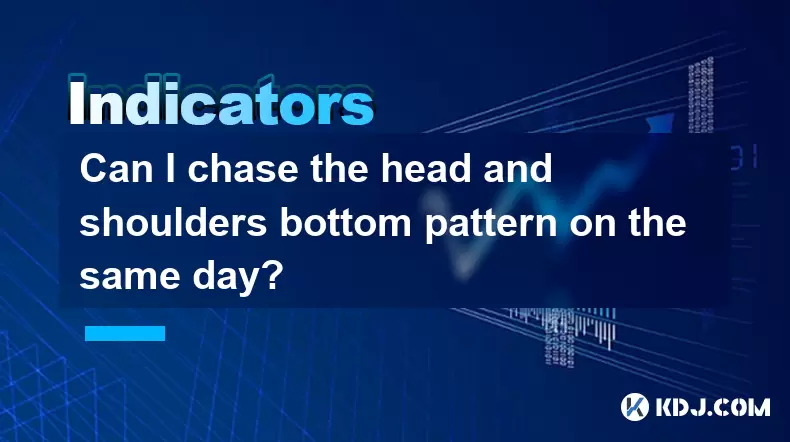
Can I chase the head and shoulders bottom pattern on the same day?
Jun 26,2025 at 06:14pm
Understanding the Head and Shoulders Bottom Pattern in Cryptocurrency TradingThe head and shoulders bottom pattern, also known as the inverse head and shoulders, is a reversal chart pattern commonly observed in cryptocurrency price charts. It signals a potential shift from a downtrend to an uptrend. The structure consists of three distinct lows: the lef...

What should I do if the 10-day line turns downward but the monthly line is still upward?
Jun 26,2025 at 08:56pm
Understanding the 10-Day and Monthly Moving AveragesIn cryptocurrency trading, moving averages are among the most widely used technical indicators. The 10-day moving average (MA) reflects short-term price trends, while the monthly moving average, often calculated over 30 days, represents long-term market sentiment. When the 10-day line turns downward, i...
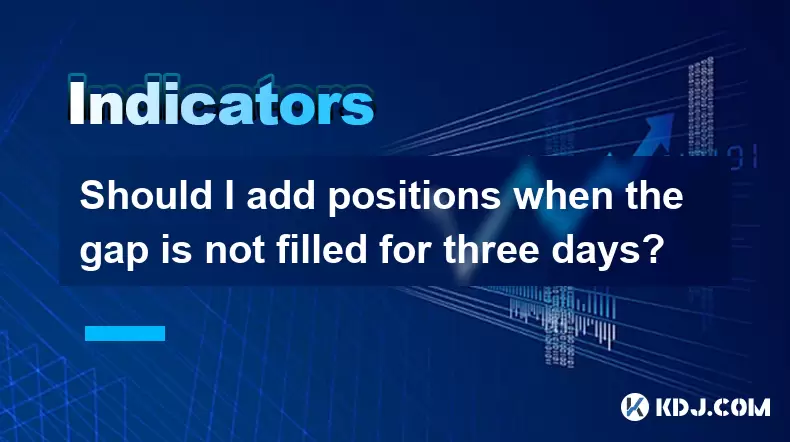
Should I add positions when the gap is not filled for three days?
Jun 26,2025 at 07:49pm
Understanding the Concept of Gaps in Cryptocurrency TradingIn cryptocurrency trading, a gap occurs when the price of an asset opens significantly higher or lower than its previous closing price, with no trading activity taking place in between. This phenomenon is common due to the 24/7 nature of crypto markets and external events such as news releases, ...
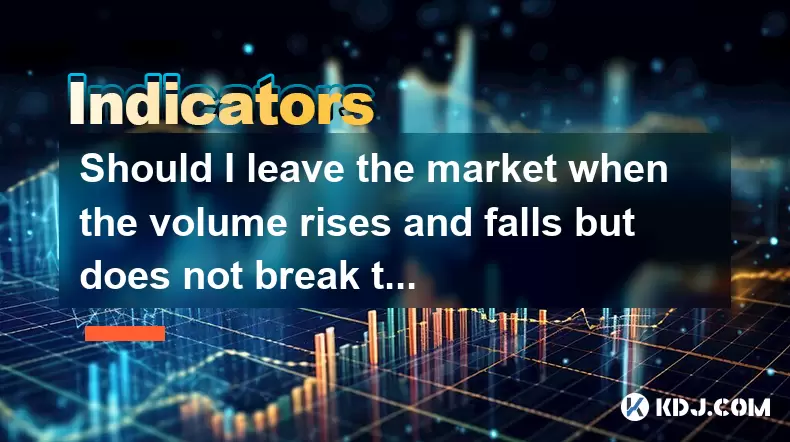
Should I leave the market when the volume rises and falls but does not break the 5-day line?
Jun 26,2025 at 06:08pm
Understanding Market Volume and the 5-Day Moving AverageWhen traders talk about market volume, they're referring to the total number of shares or contracts traded during a specific period. In cryptocurrency trading, volume plays a crucial role in confirming trends and predicting potential reversals. The 5-day moving average (5DMA) is a short-term indica...
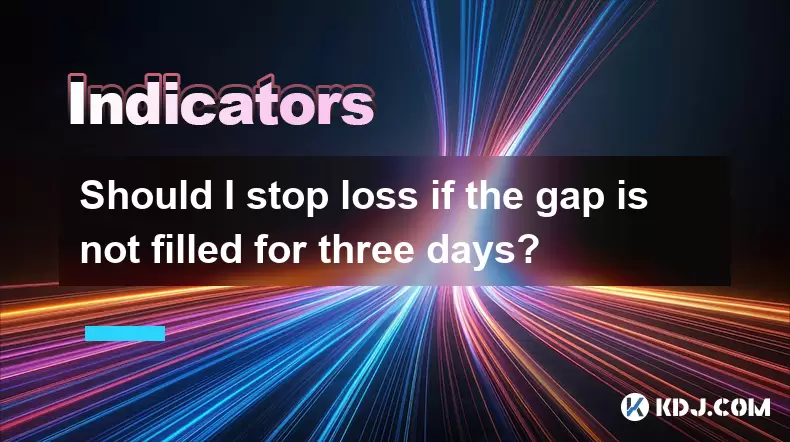
Should I stop loss if the gap is not filled for three days?
Jun 26,2025 at 06:35pm
Understanding Gaps in Cryptocurrency TradingIn cryptocurrency trading, gaps refer to areas on a price chart where the asset's price jumps from one level to another without any trading occurring at the intermediate levels. These gaps can appear due to sudden market movements, often influenced by news events, macroeconomic data releases, or shifts in inve...

If the low position continues to increase in volume but the moving average is still short, should we wait and see?
Jun 26,2025 at 08:07pm
Understanding the Scenario: Low Position with Increasing VolumeIn the cryptocurrency market, traders often encounter situations where a particular asset is trading at a relatively low price level (referred to as a 'low position'), yet there is a noticeable increase in trading volume. This phenomenon can be confusing because it suggests that more market ...

Can I chase the head and shoulders bottom pattern on the same day?
Jun 26,2025 at 06:14pm
Understanding the Head and Shoulders Bottom Pattern in Cryptocurrency TradingThe head and shoulders bottom pattern, also known as the inverse head and shoulders, is a reversal chart pattern commonly observed in cryptocurrency price charts. It signals a potential shift from a downtrend to an uptrend. The structure consists of three distinct lows: the lef...

What should I do if the 10-day line turns downward but the monthly line is still upward?
Jun 26,2025 at 08:56pm
Understanding the 10-Day and Monthly Moving AveragesIn cryptocurrency trading, moving averages are among the most widely used technical indicators. The 10-day moving average (MA) reflects short-term price trends, while the monthly moving average, often calculated over 30 days, represents long-term market sentiment. When the 10-day line turns downward, i...

Should I add positions when the gap is not filled for three days?
Jun 26,2025 at 07:49pm
Understanding the Concept of Gaps in Cryptocurrency TradingIn cryptocurrency trading, a gap occurs when the price of an asset opens significantly higher or lower than its previous closing price, with no trading activity taking place in between. This phenomenon is common due to the 24/7 nature of crypto markets and external events such as news releases, ...

Should I leave the market when the volume rises and falls but does not break the 5-day line?
Jun 26,2025 at 06:08pm
Understanding Market Volume and the 5-Day Moving AverageWhen traders talk about market volume, they're referring to the total number of shares or contracts traded during a specific period. In cryptocurrency trading, volume plays a crucial role in confirming trends and predicting potential reversals. The 5-day moving average (5DMA) is a short-term indica...

Should I stop loss if the gap is not filled for three days?
Jun 26,2025 at 06:35pm
Understanding Gaps in Cryptocurrency TradingIn cryptocurrency trading, gaps refer to areas on a price chart where the asset's price jumps from one level to another without any trading occurring at the intermediate levels. These gaps can appear due to sudden market movements, often influenced by news events, macroeconomic data releases, or shifts in inve...
See all articles
























































































